Japanese anti-aircraft artillery in anti-tank defense
Small-caliber anti-aircraft guns
In 1938, the 20-mm Type 98 automatic cannon entered into service, the principle of operation of which was repeated by the Hotchkiss M13,2 French 1929-mm machine gun. The 20-mm rapid-fire anti-aircraft gun was developed as a dual-purpose system: to combat lightly armored ground and air targets. The 98 × 20 mm shot, also used in the Type 124 anti-tank rifle, was used to fire Type 97. An 20-mm armor-piercing tracer with a mass of 109 g left the barrel with a length of 1400 mm with an initial velocity of 835 m / s. At a distance of 250 m, normal, he punched 30-mm armor, that is, armor penetration Type 98 was at the level of Type 97 PTR.
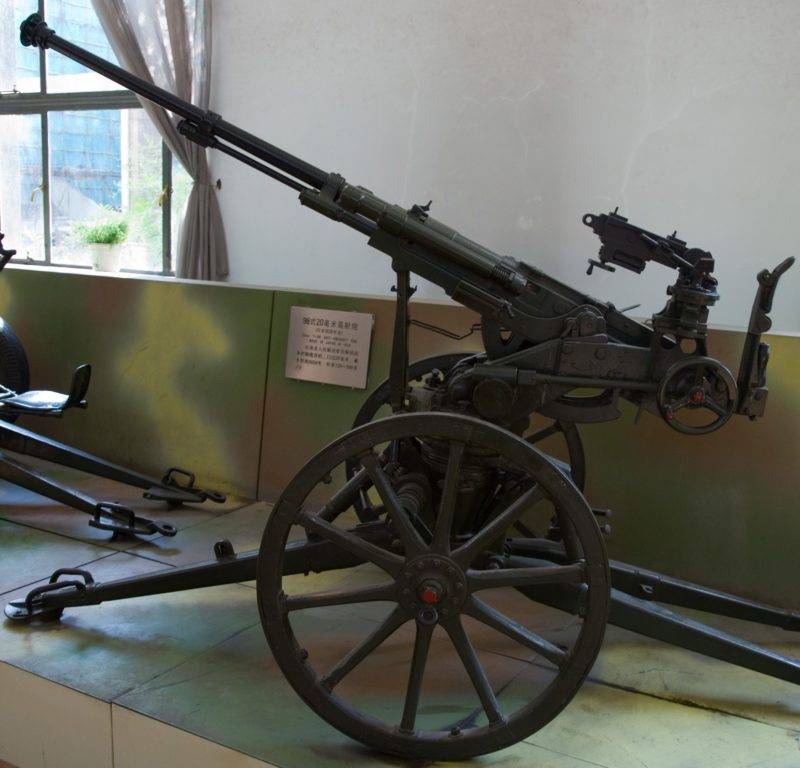
The 20-mm gun could be towed by horse-drawn carriage or light truck at speeds up to 15 km / h. A tall bed rested on two wooden wheels. In the combat position of the anti-aircraft gun was posted on three pillars. If necessary, the fire could be conducted from the wheels, but the accuracy of the fire fell.
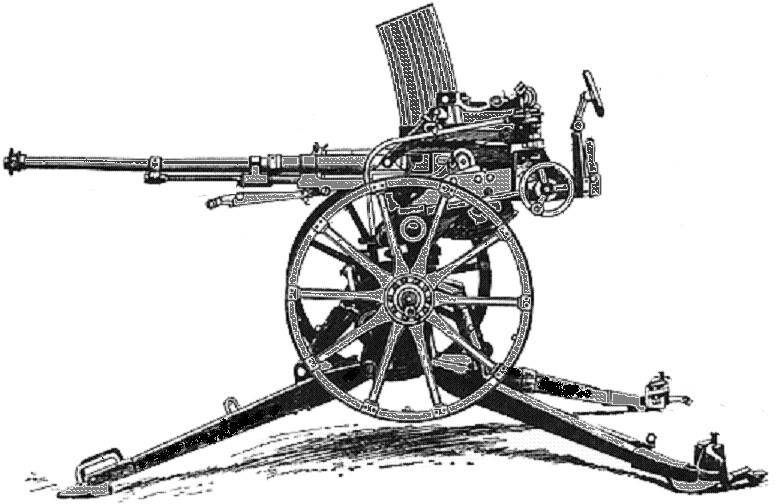
An experienced crew of six people could bring the anti-aircraft installation into a combat position in three minutes. For mountain rifle parts a collapsible modification was created, some parts of which could be transported in packs. The anti-aircraft gun had the ability to fire in the 360 ° sector, the vertical guidance angles: from -5 ° to + 85 °. Weight in the fighting position - 373 kg. Rate of fire - 300 rds / min. Combat rate - up to 120 rds / min. Power was supplied from the 20-charging store. The maximum firing range is 5,3 km. The effective firing range was approximately two times less.
Production of a small-bore anti-aircraft gun Type 98 continued from 1938 to 1945 year. About 2400 20-mm anti-aircraft guns were sent to the troops. For the first time, Type 98 entered the battle in 1939 in the vicinity of the Khalkhin Gol River. it weapon used by the Japanese not only for firing at aircraft, but also used in anti-tank defense of the front line. Characteristics of Type 98 armor penetration made it possible to penetrate armor of lungs at close range tanks M3 / M5 Stuart, M3 half-track armored personnel carriers and marine corps tracked conveyors.
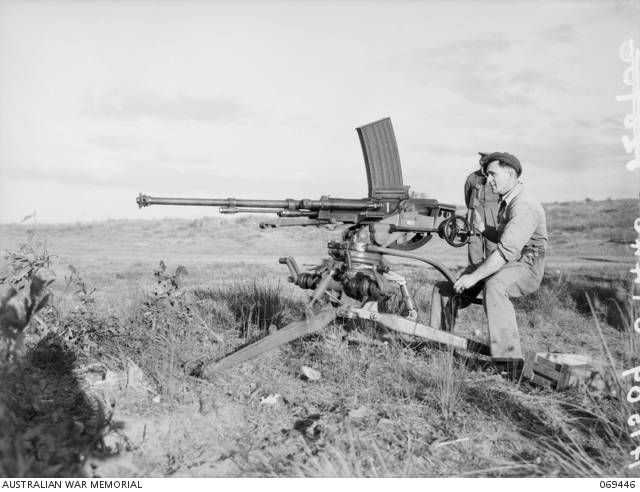
Disassembled, easily portable and masked 20-mm guns brought many problems to the Americans and the British. Very often 20-mm machines were mounted in bunkers and sweep the terrain for a kilometer. Their shells represented a great danger for airborne landing craft, including for light armored LVT amphibians and fire support vehicles based on them.
In 1944, the Type 98 began the production of a paired 20-mm Type 4 anti-aircraft gun, created using the artillery part of the Type 98. Until the capitulation of Japan, the troops received about 500 twin installations. Like single-barreled assault rifles, Sparky participated in battles in the Philippines and were attracted for anti-airborne defense.
In 1942, the 20-mm Type 2 anti-aircraft gun entered service. This model was created thanks to military-technical cooperation with Germany and was a variant of the 20-mm anti-aircraft gun 2,0 cm Flak 38, adapted to Japanese ammunition. Compared with the Type 98, the German copy was more rapid, accurate and reliable. The rate of fire increased to 420-480 shots / min. Weight in the fighting position - 450 kg, in the marching - 770 kg. At the very end of the war, an attempt was made to launch the production of a paired version of this anti-aircraft gun. But due to the limited capacity of the Japanese industry to produce a significant number of such installations failed.
After the end of World War II, a significant number of captured 20-mm anti-aircraft guns were at the disposal of the Chinese Communists, who used them during the war in Korea. Also, cases of the combat use of Japanese small-caliber mountings were noted in the second half of the 1940s during the fighting of the Indonesian forces against the Dutch military contingent and in Vietnam when repelling the raids of the French and American aviation.
The 25-mm Type 96 became the most famous and popular Japanese small-caliber anti-aircraft gun. This automatic anti-aircraft gun was developed in 1936 on the basis of the Mitrailleuse de 25 mm contre-aéroplanes gun from the French company Hotchkiss.
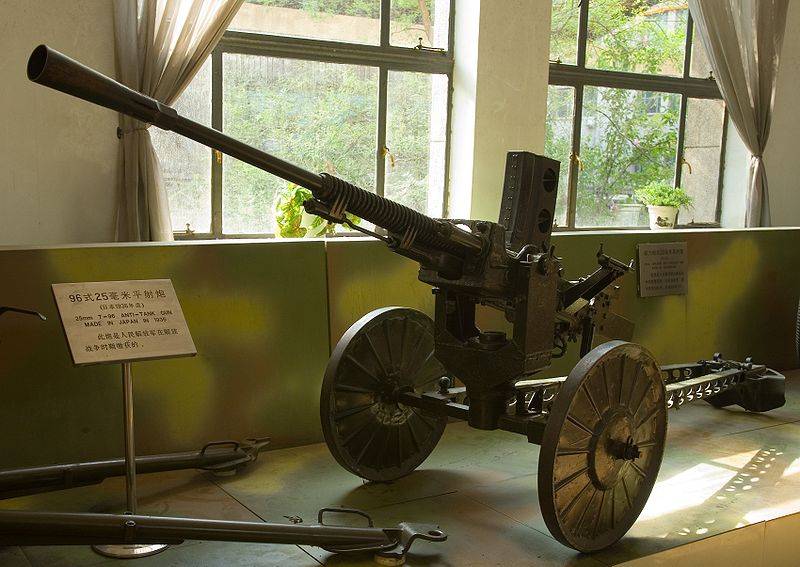
The 25-mm anti-aircraft gun was very widely used in single, paired and structured installations, both on ships and on land. The most significant difference of the Japanese sample from the original was the equipment of the flame arrester of the German company Rheinmetall. The gun was towed, the wheel position was separated in the combat position.
Single-barreled 25-mm anti-aircraft gun weighed 790 kg, paired - 1110 kg, built-1800 kg. A single barreled unit was serviced by a 4 man, a twin one - 7 man, a built one - 9 man. Used for food shops on 15 shells. The rate of firing single-barrel machine was 220-250 rds / min. Practical rate of fire: 100 — 120 rds / min. Vertical guidance angles: from -10 ° to + 85 °. The effective firing range is up to 3000 m. Reach height - 2000 m. The fire was fired with 25-mm shots with a sleeve length 163 mm. The ammunition could include: high explosive incendiary, fragmentation tracer, armor-piercing, armor-piercing tracer shells. At a distance of 250 meters, an armor-piercing projectile with a mass of 260 g, with an initial speed of 870 m / s, punched 35-mm armor. For the first time, the Japanese massively used 25-mm anti-aircraft guns to fire ground targets during the battle for Guadalcanal.
Given the fact that the Japanese industry has released about 33000 25-mm installations, Type 96 are widespread. Despite the relatively small caliber, they were quite powerful anti-tank tool. A dozen armor-piercing shells fired from a short range were quite able to “gnaw through” the frontal armor of the Sherman.
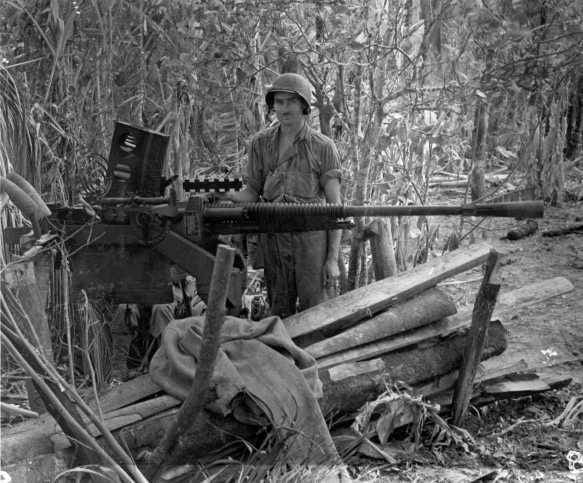
Paired and well-built anti-aircraft installations were located at pre-equipped positions, and because of the large mass of their maneuver under enemy fire was impossible. Single-barreled 25-mm could be rolled over by calculation, and they were often used to organize anti-tank ambushes.
After the Japanese occupied a number of British and Dutch colonies in Asia, a significant amount of 40-mm Bofors L / 60 anti-aircraft guns and ammunition fell into their hands.
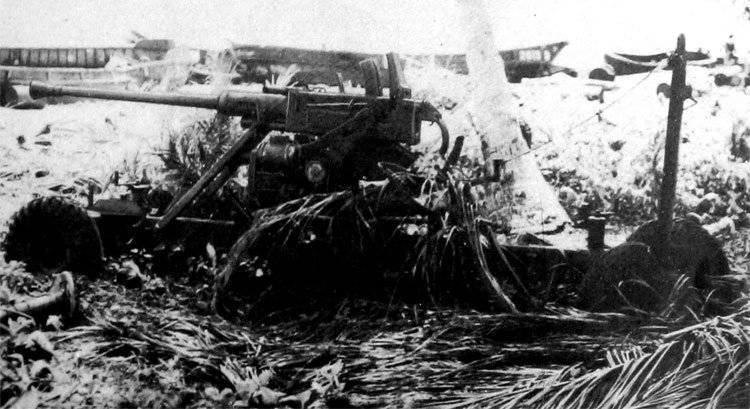
In addition to the use of captured towed "Bofors", the Japanese purposefully dismantled sea 40-mm units from captured and sank ships in the shallow-water area. Former Dutch anti-aircraft installations Hazemeyer, which used twin 40-mm "Bofors", were permanently installed on the shore and used to defend the islands.
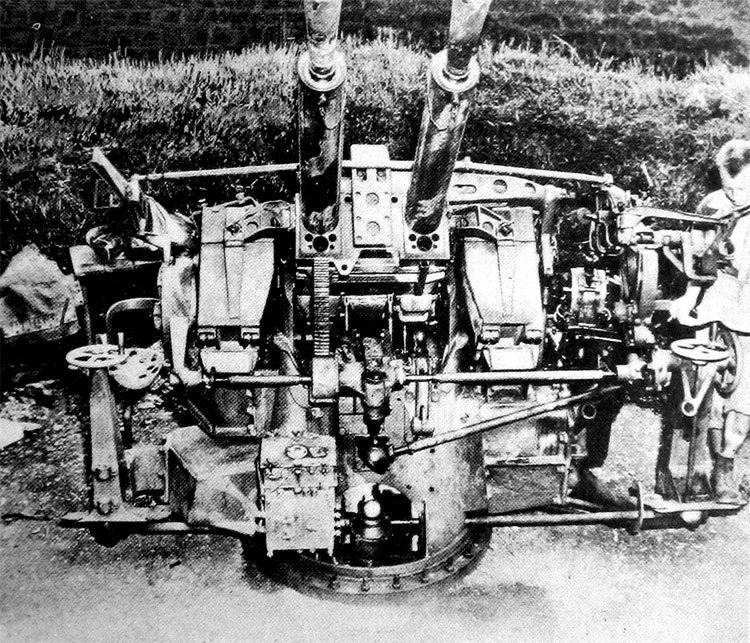
For the Bofors L / 60 anti-aircraft gun made in Sweden, the 40x311R shot with various types of shells was adopted. The main tracer was the fragmentation-tracer 900 of the projectile equipped with 60 of TNT leaving the barrel at a speed of 850 m / s. A solid armor-piercing tracer 40-mm projectile weighing 890 g, with an initial speed of 870 m / s, at a distance of 500 m could penetrate 50 mm armor, which, when fired from a short distance, made it dangerous for medium tanks.
In 1943, in Japan, an attempt was made to copy and launch the Bofors L / 60 into serial production under the designation Type 5. The guns were actually assembled by hand at Yokosuka naval arsenal at the rate of release of 1944-5 guns per month at the end of 8. Despite the manual assembly and individual fitting of parts, the quality and reliability of the Japanese 40-mm anti-aircraft guns was very low. Due to their small size and unsatisfactory reliability, several dozens of these anti-aircraft guns did not affect the course of hostilities.
Anti-aircraft and universal guns caliber 75-88 mm
The acute shortage of specialized artillery forced the Japanese command to use medium-caliber anti-aircraft guns in the anti-tank and antiamphibious defense. The most popular Japanese anti-aircraft gun, designed to combat air targets at heights up to 9000 m, was the 75-mm Type 88. This gun came into service 1928 year and the beginning of the 1940-s managed to become obsolete.
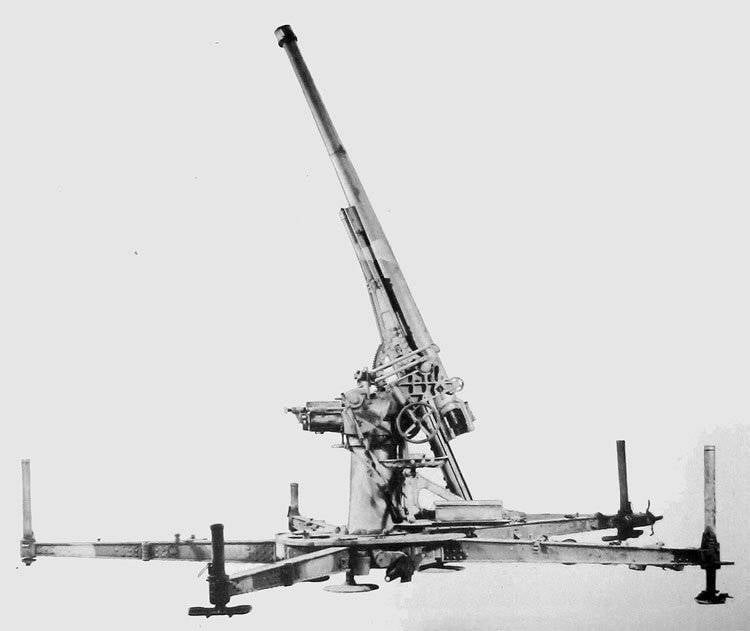
Although the Type 75 88-mm anti-aircraft gun could launch per minute to 20 projectiles, a lot of complaints were caused by excessive complexity and high cost of the weapon. The process of transferring the weapon from the transport to the combat position and back was very laborious. Especially inconvenient for the deployment of anti-aircraft guns in a combat position was such a structural element as a five-beam support, in which it was necessary to push four beds and unscrew five jacks. The dismantling of two transport wheels also took a lot of time and effort to calculate.
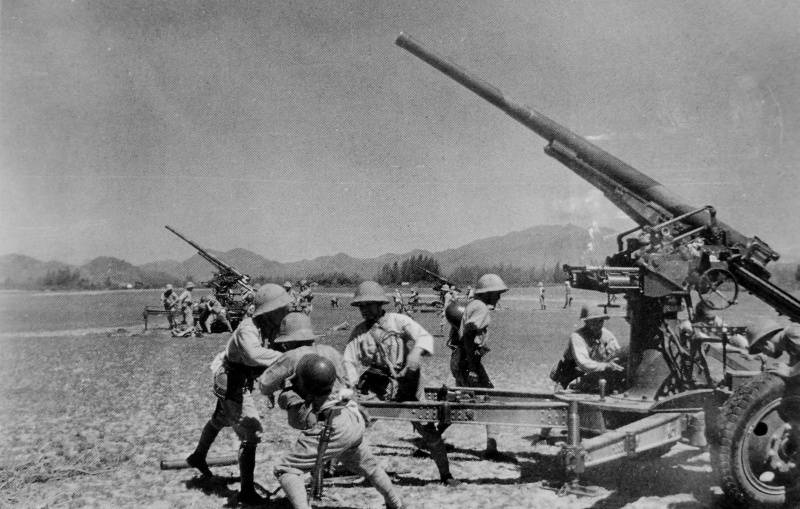
In the transport position, the gun weighed 2740 kg, in combat - 2442 kg. Anti-aircraft gun had a circular fire, the angles of vertical guidance: from 0 ° to + 85 °. For shooting from Type 88 used projectile 75x497R. In addition to the fragmentation grenade with a remote fuse and a high-explosive fragmentation projectile with a strike fuse, the ammunition unit included an armor-piercing projectile with a mass of 6,2 kg. Leaving the barrel with a length of 3212 mm with an initial speed of 740 m / s, at a distance of 500 m when hit at a right angle, an armor-piercing projectile could penetrate armor 110 mm thick.
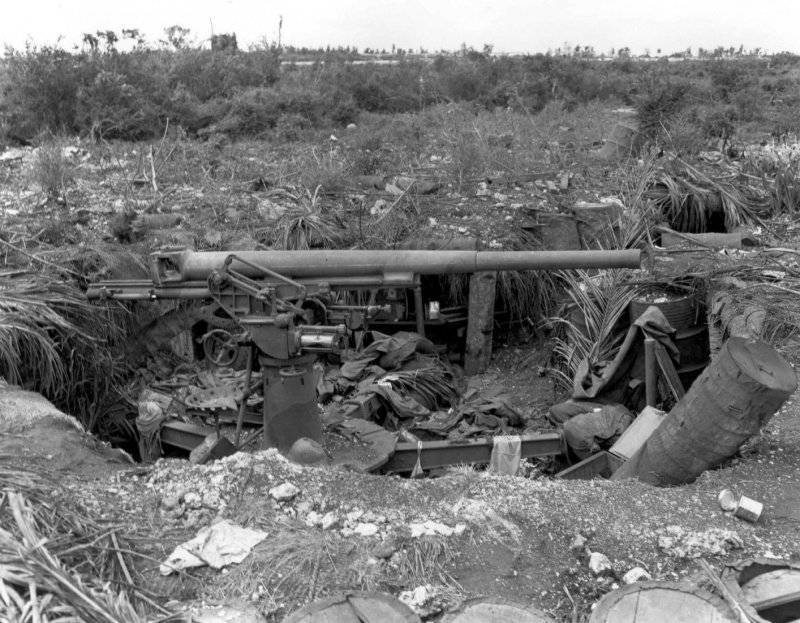
Faced with a shortage of effective anti-tank weapons, the Japanese command began deploying 75-mm anti-aircraft guns while defending the islands in tank-dangerous areas. Since the change of position was extremely difficult, the guns were actually used permanently.
In the middle of 1930 in China, Japanese troops captured several BNNXX Dutch-made 75-mm anti-aircraft guns. On the basis of this sample, an 29-mm Type 1943 gun was created in 75 in Japan. In terms of range and height, Type 4 and Type 88 were almost equivalent. But Type 4 turned out to be much more convenient to use, and was much faster deployed in position.
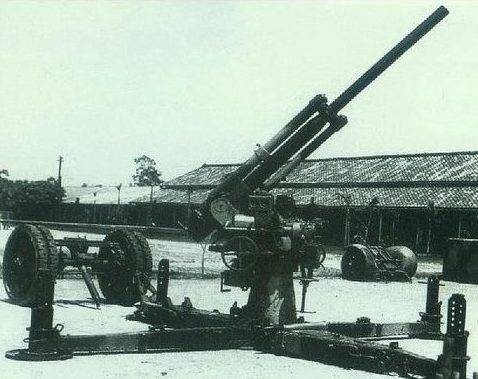
Bombing of Japanese factories and an acute shortage of raw materials did not allow the launch of mass production of Type 4 guns. In total, until August 1945 managed to release approximately 70 Type 4 anti-aircraft cannons, and they had no noticeable effect on the course of the war.
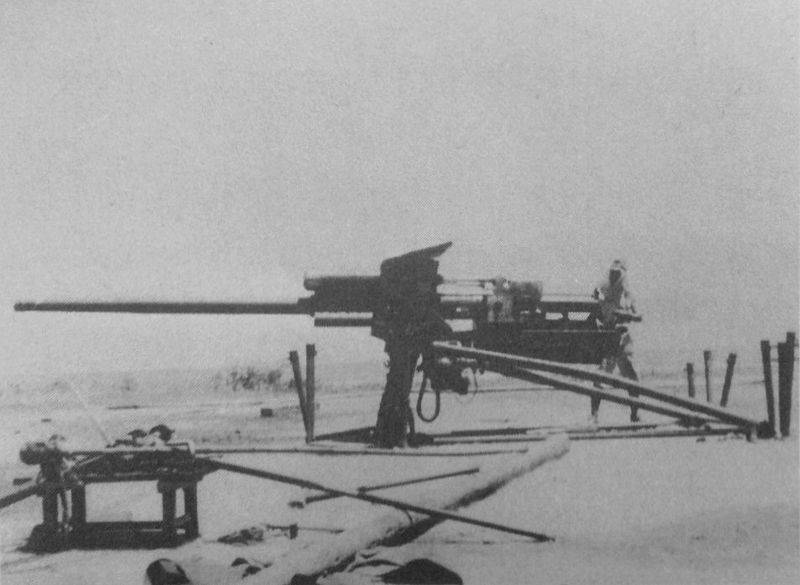
On the basis of the Type 4 anti-aircraft gun, an 75-mm Type 5 tank gun was created, which was intended to equip the Type 5 Chi-Ri medium tank and the Type 5 Na-To tank destroyer. 75-mm projectile with a mass of 6,3 kg left the barrel length of 4230 mm with an initial speed of 850 m / s. At a distance of 1000 m armor-piercing projectile normal pierced 75 mm armor.
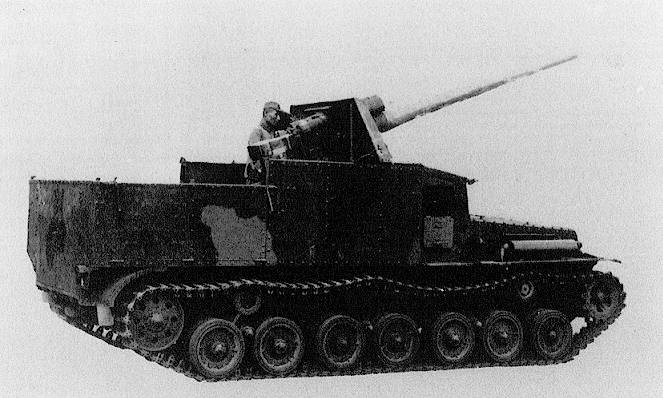
Tank Type 5 Chi-Ri in terms of security was comparable to the American M4 Sherman. The long-barreled cannon of a Japanese tank made it possible to fight any Allied armored vehicles used in the Pacific theater. The PT SAU Type 5 Na-To, based on the Type 4 Chi-So tracked carrier, was covered with 12 mm anti-bullet armor and could successfully operate from ambush. Fortunately for the Americans, the Japanese industry, working in the conditions of an acute shortage of raw materials, was overloaded with military orders, and further development of several prototype tanks and self-propelled units did not progress.
In the 1914, the Japanese Navy received a "mine" rapid-fire 76,2-mm gun Type 3. After upgrading this gun was increased angle of vertical pickup, and it got the opportunity to fire at aerial targets. For the 1920-1930-ies, the universal 76,2-mm gun had good characteristics. When the 12 firing rate per minute / min, it had an 6000 m height reach. But due to the lack of fire control devices and centralized guidance, in practice, the effectiveness of such a fire was low, and the Type 3 guns could conduct only barrage fire.
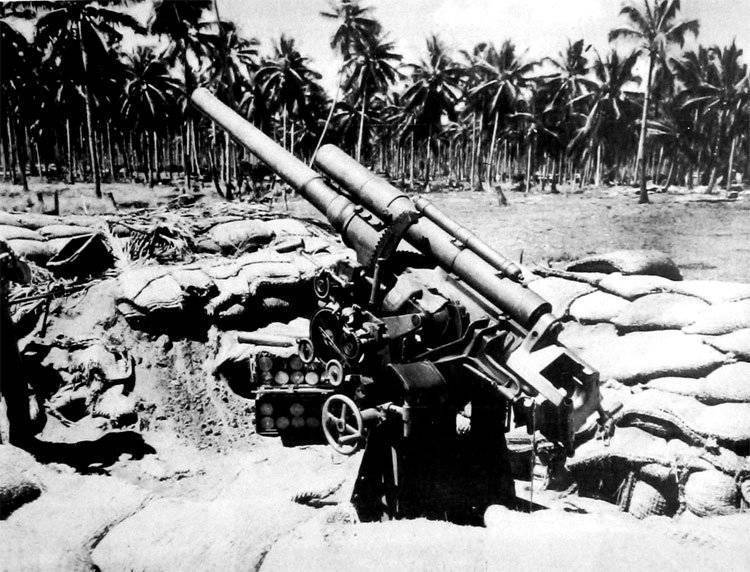
In the second half of the 1930-s, most of the dual-purpose 76-mm guns were pushed out of the ship's decks of the Type 25 96-mm anti-aircraft guns. After some refinement, approximately 60 of the released Type 3 guns were placed on the bank. They were supposed to conduct anti-aircraft fire, to perform the functions of field and coastal defense weapons.
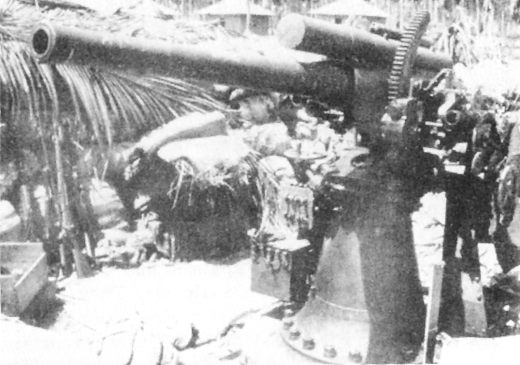
The Type 3 cannon mounted on the pedestal thigh weighed 2400 kg. The initial speed of 5,7 kg of armor-piercing projectile was 685 m / s, which made it possible to fight with American medium tanks at a distance of up to 500 m.
In addition to their own 75-mm anti-aircraft guns and 76,2-mm universal guns, the Japanese imperial army used British 76,2-mm anti-aircraft guns QF 3-in 20cwt and American 76,2-mm anti-aircraft guns МХNUMX captured in Singapore and the Philippines. In total, the imperial army in 3 had about 1942 trophy three-inch anti-aircraft guns. However, these artillery systems were obsolete by that time and did not represent much value. Enough modern were a half dozen 50-mm British guns QF 94-inch AA, captured by Japanese troops in Singapore. But at the disposal of the Japanese there were no serviceable original fire control devices, which made it extremely difficult to use captured anti-aircraft guns for their intended purpose. In this regard, most of the British and American anti-aircraft guns were used for firing at sea and land targets that are in line of sight.
In 1937, in Nanking, the Japanese army captured several 88-mm German-made 8.8 cm SK C / 30 naval guns, which the Chinese used as serfs.

The 88-mm 8.8 cm SK C / 30 gun weighed 1230 kg and, after being placed on a concrete or metal base, was able to be fired upon. Vertical guidance angles: from -10 ° to + 80 °. The initial speed of an armor-piercing projectile with a mass of 10 kg - 790 m / s. A fragmentation grenade weighing 9 kg, left the barrel at a speed of 800 m / s, and had an access height of more than 9000 m. Fighting rate of fire - up to 15 rds / min.
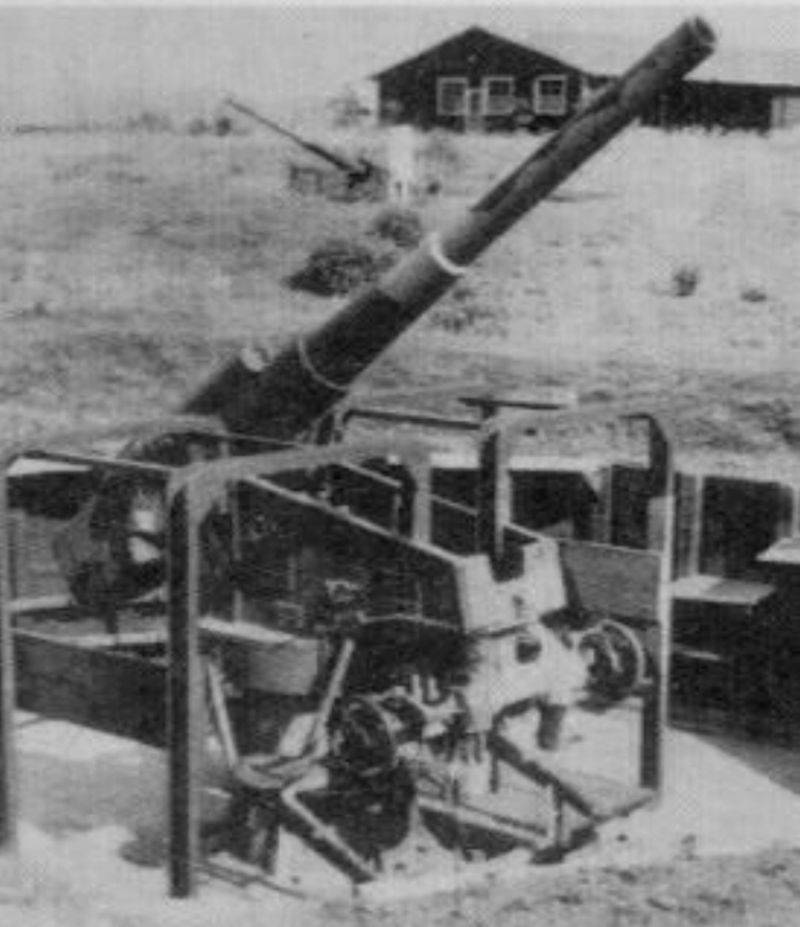
On the basis of the captured 88-mm naval gun 8.8 cm SK C / 30 was created anti-aircraft gun Type 99, entered service in the 1939 year. At a direct fire range of 88-mm armor-piercing projectile could penetrate the armor of any American or British tank, used during World War II in Asia. However, a major drawback of the Type 99, which prevented its effective use in anti-tank defense, was the need to disassemble the weapon when changing positions. According to reference data, from 1939 to 1943, the year was released from 750 to 1000 guns. They were used not only in air defense, but also actively participated in the defense of the islands on which the Americans landed amphibious assault forces. It is likely that on the account of 88-mm guns Type 99 guns have destroyed and destroyed tanks.
Anti-aircraft and universal guns caliber 100-120-mm
The 100-mm Type 14 anti-aircraft gun adopted in 1929 was very powerful for its time. Externally and constructively, it was similar to the 75-mm gun Type 88, but it was heavier and more massive.
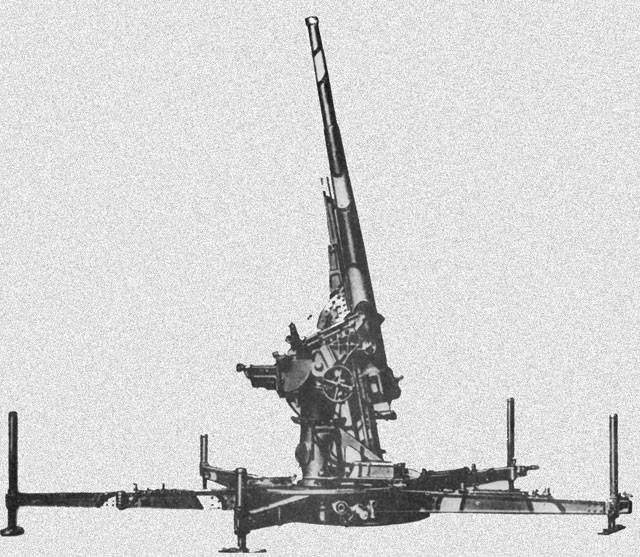
100-mm anti-aircraft guns could fire planes flying at a height of up to 10000 m, releasing per minute to 10 projectiles. Since the weight of the gun in the transport position was close to 6000 kg, there were difficulties with its transportation and deployment. The frame of the gun rested on six sliding legs. Each paw had to level the jack. For undoing the wheel travel and transfer of anti-aircraft guns from the transport to the combat position, the calculation required the smallest 45 minutes. Since the 100-mm anti-aircraft gun was very expensive to manufacture, and its power for the first half of 1930-s was considered excessively high, only 70 units were released. Due to the difficulty of redeploying and the small number of guns in service, the Type 14 was not used in land battles with British and American troops.
After the start of the bombing of Japan, it turned out that the 75-mm anti-aircraft guns proved to be ineffective against the American B-17 bombers and were absolutely unsuitable for countering the B-29 raids. In 1944, it became clear that Japan had finally lost its strategic initiative, the Japanese command was preoccupied with strengthening air defense and anti-airborne defense. To this end, it was decided to use the Type 100 98-mm twin-mounted artillery. According to American experts, this is the best Japanese universal naval artillery of medium caliber. She had excellent ballistics and high rate of fire. Installation Type 98 was produced in a closed tower and half-open versions. 100-mm twin guns were placed on destroyers of the Akizuki type, Oyodoi cruisers, aircraft carriers Taiho and Shinano.
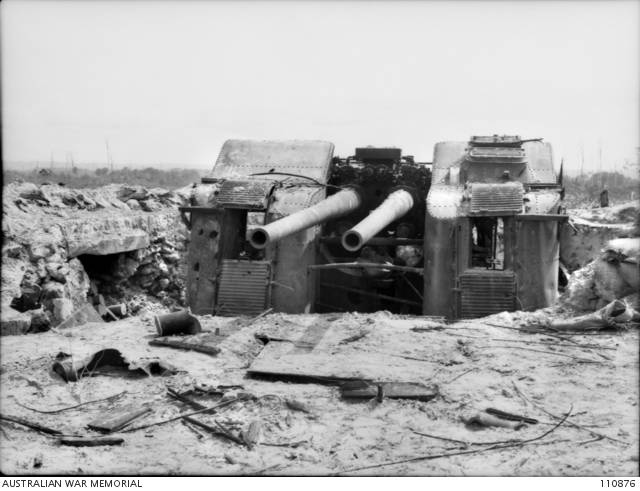
100-mm Type 98 artillery mount captured by Australian troops in Balikpapan, Borneo
The total mass of the semi-open 100-paired installation was about 20000 kg. Fighting rate: 15-20 rds / min. The initial velocity of the projectile - 1030 m / s. Vertical guidance angles: from −10 to + 90 °. Fragment 13 kg of a grenade with a remote fuse could hit targets at altitudes up to 13000 m. The explosive charge with 2,1 kg mass ensured a radius of damage to air targets with shrapnel - 14 m. Thus, the Type 98 was one of the few Japanese anti-aircraft guns capable of reaching the American bomber B-XNMH. flying at cruise altitude.
In the period from 1938 to 1944, Japanese industry passed the fleet 169 Type 98. Since 1944, 68 of these have been located ashore. These guns, due to their long firing range and high rate of fire, were a very good anti-aircraft weapon, and the horizontal firing range of 19500 m made it possible to control coastal waters.
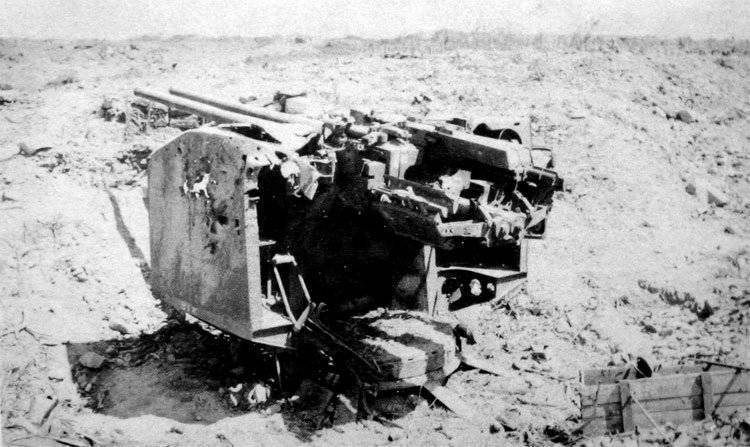
In the course of carrying out operations to seize the Pacific Islands, the American command was forced to allocate additional forces and means to suppress 100-mm coastal batteries. Although Type 98 ammunition only included 100-mm grenades with remote and high-explosive fragmentation projectiles, if British or American tanks were in their direct fire zone, they would quickly become scrap metal. When setting the contact fuse to slow down or firing remote grenades with a fuse set to the maximum range, the projectile's energy was enough to break through the Sherman frontal armor.
The 120-mm gun Type 10, production of which began in the year 1927, was also widely used for the defense of the islands. Initially it was intended to arm destroyers and light cruisers. Subsequently, the gun was upgraded and used as a universal, including ashore.
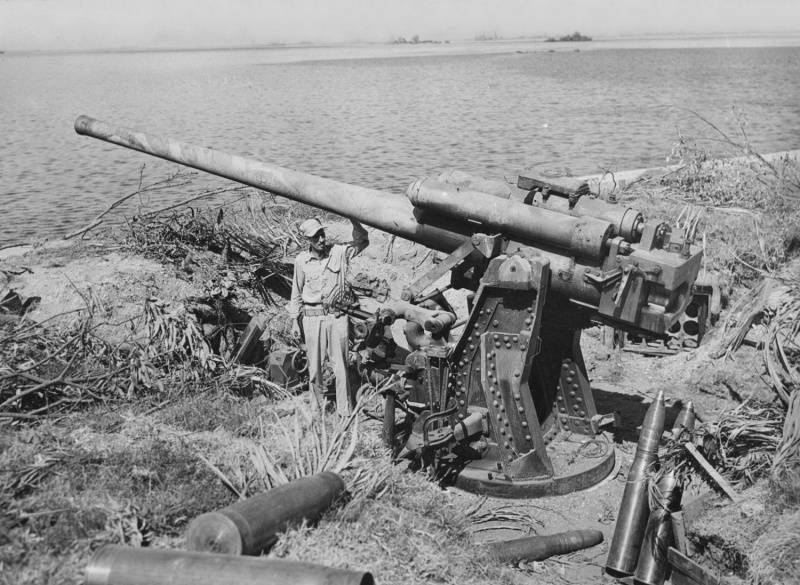
The gun had quite good characteristics. With a total mass of more than 8000 kg, it could send 20,6 kg fragmentation grenade to a distance of 16000 m. In the barrel 5400 mm long, the projectile accelerated to 825 m / s. Reach in height - 8500 m. Type 10 had the possibility of a circular attack, the corners of the vertical pickup: from 5 to + 75 °. The semi-automatic wedge valve allowed 12 shots / min. The ammunition consisted of fragmentation grenades with a remote fuse, armor-piercing high-explosive, high-explosive fragmentation and fragmentation-incendiary shells with a contact fuse.
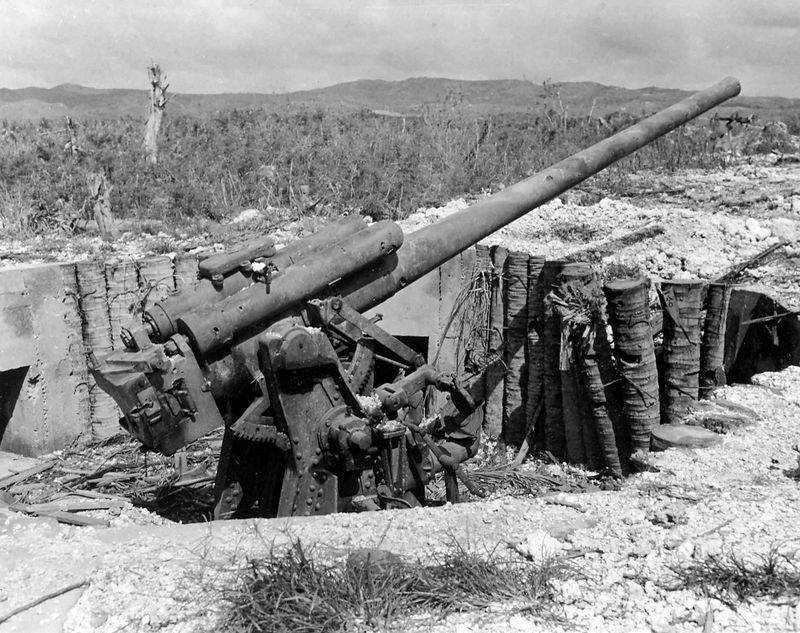
From 1927 to 1944, about 2000 guns were produced a year, about half went into coastal artillery. Type 120 10 mm guns were used in all major Japanese defensive battles. Shooting at air, sea and land targets was conducted from positions prepared in engineering terms.
The combat effectiveness of the Japanese anti-aircraft artillery in anti-tank defense
Considering the results of the combat activities of the Japanese anti-aircraft and universal artillery in the anti-tank defense, it can be stated that in general it did not justify the hopes of the Japanese command. Despite some military successes, the 20-25-mm anti-aircraft guns were too weak to effectively counteract medium tanks. Given that 75-120-mm anti-aircraft guns were able to penetrate the frontal armor of British and American tanks, the weight and dimensions of the Japanese artillery systems were in most cases too large to be quickly placed in the path of enemy armored vehicles. For this reason, the Japanese anti-aircraft and universal guns, as a rule, fired from stationary positions, which were quickly intersected and subjected to intense shelling and bombing and air assault. A large variety of types and calibers of Japanese anti-aircraft guns created problems with the preparation of calculations, the supply of ammunition and the repair of guns. Despite the presence of several thousand anti-aircraft guns prepared by the Japanese for firing at ground targets, it was not possible to organize effective anti-airborne and anti-tank defenses. Much more tanks than from the fire of the Japanese anti-aircraft artillery, parts of the American marines lost drowned during landing from amphibious ships, exploded on land mines and from the actions of ground kamikazes.
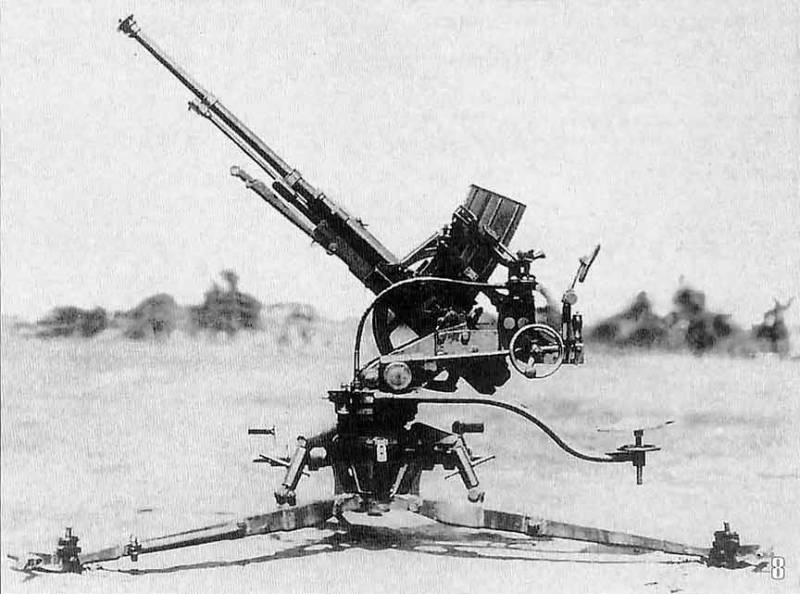
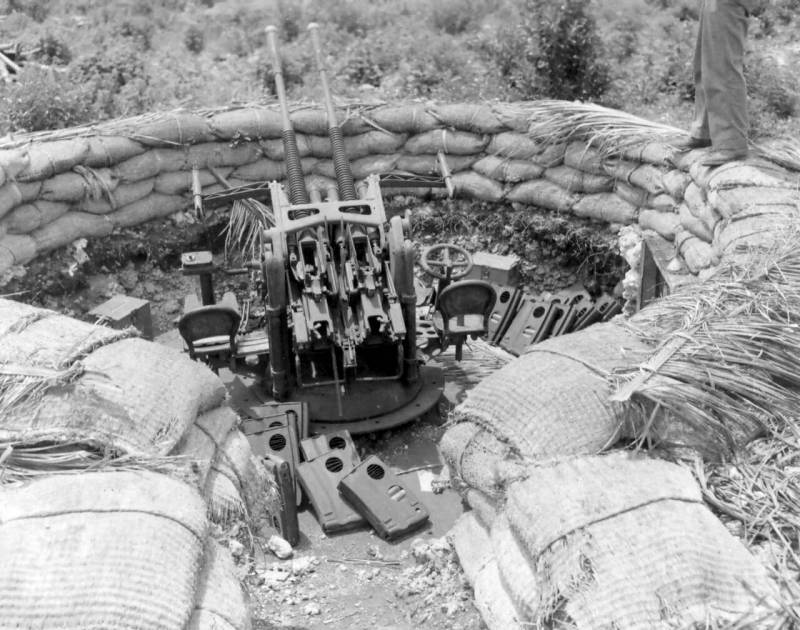
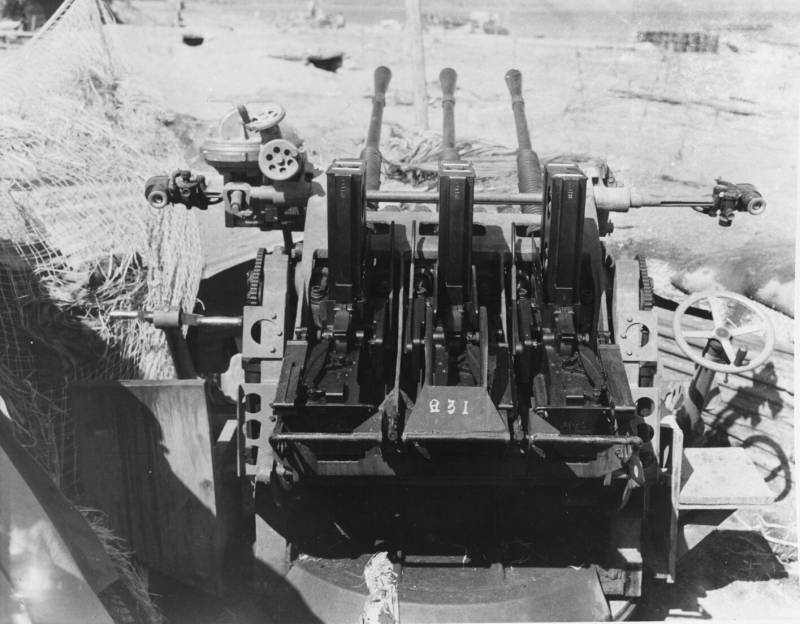
Information